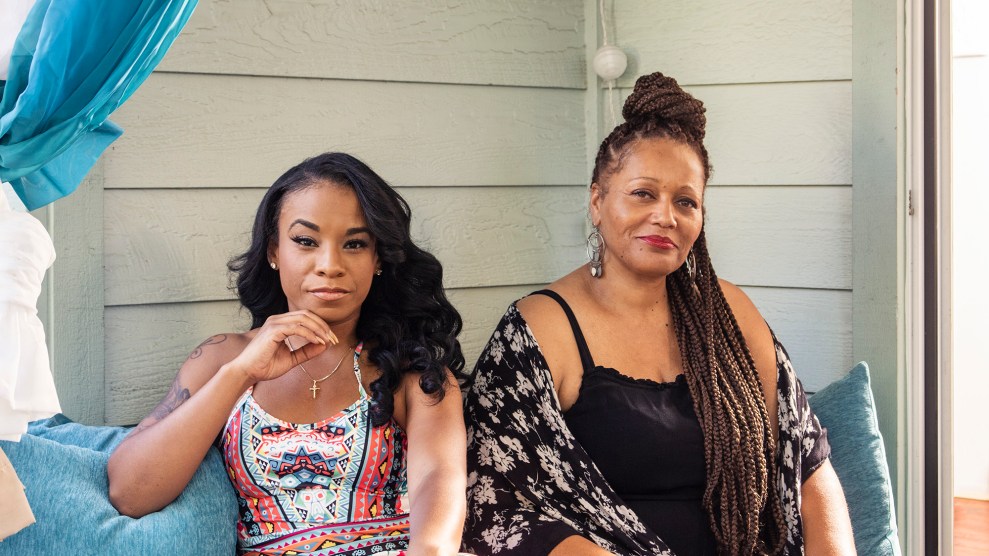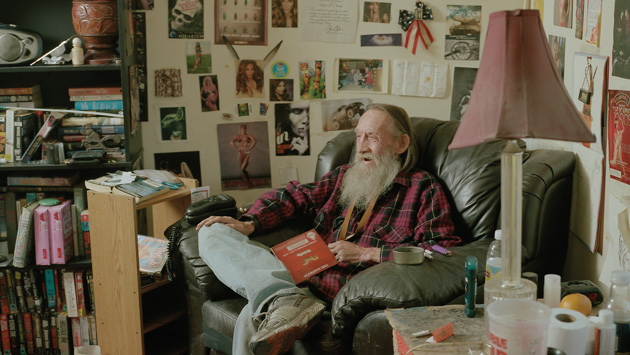
Mother Jones illustration; Getty
After 15 long years behind bars, Terah Lawyer needed to show the parole board she had somewhere lined up to live. She landed a spot in a facility on Treasure Island and was so grateful to be out that at first she didn’t mind being forced to spend dozens of hours a week in treatment classes for a substance abuse problem she didn’t have, and in fact, as a drug and alcohol counselor, was certified to teach about. But quickly, the program’s strict schedule and tough restrictions, like lockdowns on holidays and limited free time, got in the way of adjusting to real life. Before she left prison, she’d worked hard to secure a job with the California Coalition of Women Prisoners, but her facility’s rules forced her to delay her start date three months, and she lost the opportunity. Most painfully, the program’s structure made it hard to visit with her parents, who lived a couple hours north in Sacramento.
“The whole process of transitioning was hindered and stalled,” Lawyer says. “It handicapped me in certain areas because I didn’t have that immediate exposure I needed to see what life was like out here.”
Once she was finally able to start working, she’d leave the house at 7 a.m., work a full day, and get back in time for the hour-and-a-half class at night. “I was required to still bring in 21 hours of treatment classes in order for me to get my weekend passes to go home, to go shopping, to go out with family or friends, to do things that are considered freedom,” she explains. “It was really difficult being able to hold down a full-time job, which is thankfully now giving me an income, and also meet the program’s requirements of classes that I didn’t even need in the first place.”
Lawyer’s experience—and her stunted post-prison transition—is far from unique. For the thousands of people each year trying to put their incarceration behind them, stable transitional housing can be critical to their success, but in many cases the current system gets in the way. Social and structural barriers, from NIMBYism to rental and employment discrimination against felons, have long made finding housing incredibly difficult for formerly incarcerated people—in fact, they’re 10 times more likely to be homeless than the general population. There are simply few good options, particularly for people leaving prison after long sentences and facing a radically changed world. Like Lawyer, they may get stuck in a program for substance treatment even when they have no history of drug or alcohol abuse, or they can end up in places that look and feel like the prisons they just left.
While this is an issue across the country, over the past decade California has become something like ground zero for the problem, with its affordable housing crunch and a slate of laws reforming tough-on-crime policies that have offered release for thousands of people. While the state has taken steps to mitigate the problem in recent years, reentry housing is still a huge crisis that shows few signs of abating. In the end, many people who most need support when they’re let out will fall through the cracks.
Crystal Wheeler got out of prison in 2012 after 22 years inside and she struggled with PTSD from her decades behind bars, as well as her husband’s severe control and abuse. She had no family nearby, so her parole conditions required she stay in a reentry housing program. The only available option was a six-month program in Claremont, California, with a heavy emphasis on drug and alcohol treatment, despite the fact that she’d never had a substance abuse issue. “I didn’t need to go to AA meetings at 6 a.m.,” Wheeler says. “That time could have been better used for teaching us things that our husbands never let us do.”
Still, this kind of set up was typical. Most reentry housing options have traditionally focused on treating drug and alcohol dependence. When the concept of prison reentry housing caught on, facilitators looked to the only similar service sector with infrastructure in place: residential programs treating addiction. Substance abuse treatment was also already used inside prisons as an indicator of successful rehabilitation; parole boards often looked at prisoners’ completion of a 12-step program—once one of the few available programs behind bars—as a measure of suitability for release.
Prisons and substance abuse have long been genuinely linked, especially as the “war on drugs” played a significant role in building up the prison population. Forty-five percent of people incarcerated by the Federal Bureau of Prisons are in on drug-related charges—the leading offense by far. Research shows that the majority of people in US prisons do suffer from substance abuse disorders. This corresponds to a prison population that tends to be younger and serving shorter sentences (the average is 2.6 years in state prisons) and has a stubbornly high likelihood of reoffending.
“Often people coming out are at a younger age—people who might be going in and out [of prison] instead of staying a long time,” says Leigh Courtney, a policy associate focused on mass incarceration at the Urban Institute, an economic and social policy think tank in Washington, DC. Residential programs therefore have continued to target those who dominate the system, who face “a really different set of circumstances and experiences. In some ways it makes sense, but then that leaves people who are exiting after long sentences with a real lack of services.”
That gap has become increasingly apparent in California as criminal justice reforms play out. The state’s prison population has dropped by about 25 percent in the past decade, driven by policy changes like amending the three strikes law, allowing lifers to apply for reduced sentences, and expanding eligibility for parole consideration. Between 2017 and 2018, there was a 7 percent increase in the number of lifers released from state prisons, a 25 percent increase in three-strikers released, a 48 percent jump in releases for people serving life without parole sentences, and a 50 percent increase in releases for those who were condemned—over 1,100 people in total (though these statistics also account for deaths).
“A lot of those people are all starting to come out now. They’ve all been in prison for a really long time,” says Susan Champion, a lawyer who works with three-strikers and serves as president of the board of directors of Options Recovery Services, an organization that runs sober living housing in the East Bay. “We really need to be thinking about how we serve that population.”
Being thrust into an environment with mostly younger people openly struggling with substance disorders can be a particularly difficult way to transition for this population. “For many of my clients, who really just want to come out and get a job and get to work, it’s very unsettling for them to be flung into this kind of chaotic environment that, frankly, some of them find to be a little bit dangerous,” Champion says. “Providing returning citizens like that with a stable home and specialized services for them, I think there’s something that’s really missing.”
The parole board determines the fate for people handed life sentences. Before a parole board will agree to release, the prisoner needs to have a place to stay. That could be with a family member, but roughly 80 percent of this population gets state-backed or philanthropically supported transitional housing. A May 2019 report from University of California, Berkeley, found 76 transitional housing facilities where people who’ve served long and indeterminate sentences could end up.
Lawyer recalls that her house allowed visitors from 1 p.m. to 5 p.m., “less time to spend with your family than in prison.” (At Central California Women’s Facility, visiting hours are 9 a.m. to 3 p.m. on weekends.) On some holidays, like Fourth of July and New Year’s Eve, the program put the house on lockdown “because they figured it was a highly affiliated drug and alcohol day,” Lawyer says. Since her father was sick and unable to travel, Lawyer had to get notes from his doctor in order to request a travel pass.
“I had to jump through so many ridiculous hoops in order to just go home,” she says. “My father was going through so many different health issues at the time. I had my parole officer approving travel passes that the house would not allow me to use.”
In hindsight, there were things about Wheeler’s facility that she liked, but persistent early-morning AA/NA classes, rules against cell phones, and other restrictions felt like a waste of precious time. “I resented having to go through this in the transitional program because I had other needs, and I wanted to get ahead of the game,” she says. When she’d get up at 5 a.m. for meetings every day, she’d think, “My god, I didn’t sleep for 22 damn years, and now I still can’t sleep.” When temp agencies tried to contact her with work opportunities, she missed them since they were only allowed to use the phone for an hour around 4 p.m. “I didn’t even know that I was getting the calls until at the end of the day, and by now [positions are] all filled,” she remembers.
Even when programs aren’t specifically mandating substance abuse treatment, many are highly restrictive and run on tight budgets. A contract for a Los Angeles–based coalition providing reentry housing, for instance, stipulates that costs, including food, not exceed $35 per person per day. In bedrooms, people can be allotted as little as 27.5 square feet, according to the UC Berkeley report, amounting to just over half the size of a two-person prison cell.
“We need to have services that match the needs of people. And if we’re not doing that, we’re undermining peoples’ ability to succeed,” says Shawn Rowland, who started Our Road Prison Project to meet the needs of former lifers. “When our clients are mixed with other folks, the program is not going to focus on the five clients that have these specific needs when they have all these other clients who have different needs. They just get lost in the shuffle.”
Adjusting to life on the outside feels like “there’s a sense of an arrested development,” says Jesse Vasquez, who served 19 years and participated in a housing pilot program for people who had been sentenced to or served 10-plus years.
It took time for Vasquez to get his bearings; as I previously wrote in a profile of that pilot program, the first time he took a bath, he told me he filled the water too high, and the tub overflowed when he got in. And the first time he cooked, he set off the fire alarm and panicked that the cops or paramedics would show up. “The problem was that I was still thinking that I’m still 17. But here I am, I’m 36, and how do I interact in an adult world?”
On top of navigating a changed world—learning to use smartphones, the internet, and so much more—many people struggle in reentry facilities that can be hectic, if not dangerous. Richard, who asked to be identified by a pseudonym, tells me he felt traumatized by his roughly six months at a large facility run by VOA in West Oakland. VOA takes a certain number of people sentenced to life like Richard, 55, who served more than two decades. He says there were up to eight people per room, invasive searches, and blood and feces on the bathroom floors. He saw drug use, fighting, stealing.
“That whole environment reminds you of prison. It really does,” Richard says. “That’s what I hate about it. I had just served 23 years, and coming out I’m supposed to be free. I didn’t feel very free.”
Richard kept on track, working while taking classes to earn his bachelor’s degree. But he was constantly on edge. “It made me angry, paranoid, stressed, depressed,” he says. “And the scary thing about it is that some of the guys in the program, their conduct is so reckless and violent that I thought I might have to protect myself by getting in an altercation.” (VOA refused to comment for this article.)
Sometimes it wasn’t just his physical safety, but his very freedom that felt in the balance. Once he came home and his roommate had left drug paraphernalia on Richard’s bed, which could have violated his parole. “I spent 25 years rehabilitating myself and fixing my life,” Richard says. “One of the things the parole board told me is to stay away from drugs, and then I’m put in a program where that’s exactly what I’m around.” He filed grievances, told his parole agent, and even talked to a lawyer, and eventually he was able to move to a better and smaller facility more geared toward his needs.
The California Department of Corrections and Rehabilitation (CDCR) has acknowledged the vast shortcomings in reentry housing. In 2014, the department instituted a policy to reduce the number of people without substance abuse problems ending up in treatment facilities. A 2016–2017 budget change proposal noted that “in recent years the number of life term offenders being released after serving lengthy periods of incarceration has steadily increased” and that allocating more funds for housing tailored to people locked away long-term “increases availability of residential treatment beds for parolees with an identified need instead of using the program space to house a life term offender without a substance use disorder treatment need.” In 2016, the state allocated $10 million for reentry services for people who served long sentences, and the following year CDCR started a six-month transitional housing program.
Doug Bond, CEO of the Amity Foundation, which runs reentry facilities, tells me the steps CDCR and state legislators have taken to course-correct have allowed programs like his, which includes a campus serving and staffed by former lifers, to grow. But still, reformers say they’re not enough.
Lawyer, who now works in prison reentry services, says the bottom line is there’s just not enough space to match the massive need. “They put people where there’s beds available,” she says. For example, CDCR’s long-term transitional housing program had 257 beds in associated facilities as of 2018. This pales in comparison to the demand: In 2014, California’s Board of Parole Hearings granted parole to 902 people serving life terms, and it estimates 20,500 people incarcerated long-term will be eligible for a suitability hearing over the next decade.
Beyond space, experts also worry about conditions when reentry facilities are run by for-profit corporations and private prison companies. In 2017, CDCR contracted with the for-profit company GEO Reentry Inc. to manage some of the housing for people who’d served long sentences. GEO has a reputation for poor conditions and bad oversight in the private prisons it runs. California passed a law in October banning for-profit prisons in the state, including GEO, for such reasons. Yet the legislation does not apply to the company’s provision of reentry services. (Private prison companies are increasingly moving into this business; a 2017 International Business Times investigation found GEO Group doubled its investment in reentry programs in one year, much of it focused on substance abuse treatment.)
Ideal programs are hard to come by, but they are out there. Advocates describe the best ones as having peer support in a setting small enough to feel homelike, but big enough to have staff and funding to help residents navigate obstacles after long-term incarceration—getting identification cards, reuniting with family, and overcoming years of trauma. But the key issue is funding, as these programs are inherently more expensive. Richard actually loved the facility where he first stayed, surrounded by other lifers. Everyone got along well, and he could easily get to work and school. But the funding got cut, and Richard had to move to VOA. When he finally managed to get transferred to a small program in a good neighborhood in San Leandro, he started to feel settled. “It made me feel not like an ex-con but a citizen,” he says. But the relief was short-lived, as the funding for that program was cut, too, and he had to move again. It’s hard to get established when he’s “tossed around,” he says.
Despite the hurdles, creative solutions are cropping up, some with support from the state. In July, the state awarded $65 million in housing grants to community-based organizations, with a slice going to programs focused on people who had long or life sentences, like Bond’s Amity Foundation. And Lawyer is now the program manager for an innovative pilot program, the Homecoming Project, that pairs formerly incarcerated people returning after long sentences with community members with an extra room—the project I recently profiled. In the Homecoming Project, a case manager helps participants map out and accomplish individual goals while they live as a tenant in someone’s home; the results have been promising but are necessarily limited in scope.
“We have to make sure that they’re getting the best services,” Bond says of this population. “The margin of error is zero for us. It has to be because that one person that ends up on the news can undo years of good work and thousands of people returning back to the community. Once people stop being released, those doors close a lot easier than they open.”













